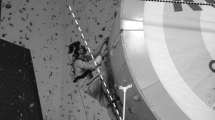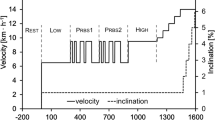Abstract
The regression of oxygen uptake (O2) on power output and the O2 demand predicted for suprapeak oxygen uptake (O2peak) exercise (power output = 432 W) were compared in ten male cyclists [C, mean O2peak = 67.9 (SD 4.2) ml · kg−1 · min−1] and nine active, yet untrained men [UT, mean O2peak = 54.1 (SD 6.5) ml · kg−1 · min−1]. The O2-power regression was determined using a continuous incremental cycle test (CON4), performed twice, which comprised several 4-min exercise periods progressing in intensity from approximately 40%–85% O2peak. Minute ventilation (E), heart rate (HR), respiratory exchange ratio (R), blood lactate concentration ([1a−]b) and rectal temperature (T re) were measured at rest and during CON4. The slope of the O2-power regression was greater (P ≤ 0.05) in C [12.4 (SD 0.7) ml · min−1. W−1] compared to UT [11.7 (SD 0.4) ml · min−1 W−1]; as a result, the O2 demand (at 432 W) was also higher (P ≤ 0.05) in C [5.97 (SD 0.23) l · min−1] than UT [5.70 (SD 0.15) 1 · min−1]. ExerciseR and [la−]b were lower (P ≤ 0.05) in C .in comparison to UT at all power outputs, whereas E and HR were relatively lower (P ≤ 0.05) in C at power outputs approximating 180 W, 220 W and 270 W. Differences in fat metabolism estimated over the first three power outputs accounted for approximately 19% of the difference in O2-power slopes between the groups and up to 46% of the difference in O2 at a given intensity. Although the O2-power regressions were linear for C [r = 0.997 (SD 0.001)] and UT [r = 0.997 (SD 0.001)], the O2-power slope was higher at power outputs at or above the lactate threshold (13.2 ml · min−1 · W−1 than at lower intensities (11.6 ml · min−1 · W−1) in C, an effect which was less profound in UT. As a result, the exclusion of O2 at the highest power outputs completely abolished the difference in O2-power slopes between C and UT. Thus, the relatively higher O2 during incremental exercise in C can be almost entirely attributed to the higher O2 cost of cycling at higher power outputs. In addition, the presence of non-linear responses in O2 at higher intensities also confirms the invalidity of describing the O2 response across a wide range of power outputs using a linear function, and challenges the validity of predicting the O2 demand of more intense exercise by a linear extrapolation of this same function.
Similar content being viewed by others
References
Bahr R, Opstad PK, Medbø JI, Sejersted OM (1991) Strenuous prolonged exercise elevates resting metabolic rate and causes reduced mechanical efficiency. Acta Physiol Scand 141: 555–563
Bangsbo J, Gollnick PD, Graham TE, Juel C, Kiens B, Mizuno M, Saltin B (1990) Anaerobic energy production and O2 deficit-debt relationship during exhaustive exercise in humans. J Physiol (Lond) 422:539–559
Bangsbo J, Michalsik L, Petersen A (1993) Accumulated O2 deficit during intense exercise and muscle characteristics of elite athletes. Int J Sports Med 14:207–213
Barstow TJ, Mole PA (1991) Linear and nonlinear characteristics of oxygen uptake kinetics during heavy exercise. J Appl Physiol 71:2099–2106
Catcheside PG, Scroop GC (1993) Lactate kinetics in resting and exercising forearms during moderate-intensity supine leg exercise. J Appl Physiol 74:435–443
Coyle EF, Feltner ME, Kautz SA, Hamilton MT, Montain SJ, Baylor AM, Abraham LD, Petrek GW (1991) Physiological and biomechanical factors associated with elite endurance cycling performance. Med. Sci Sport Exerc 23:93–107
Coyle EF, Sidossis LS, Horowitz JF, Beltz JD (1992) Cycling efficiency is related to the percentage of type I muscle fibers. Med Sci Sport Exerc 24:782–788
Craig NP, Norton KI, Bourdon PC, Woolford SM, Stanef T, Squires B, Olds, TS, Conyers RAJ, Walsh CBV (1993) Aerobic and anaerobic indices contributing to track endurance cycling performance. Eur J Appl Physiol 67:150–158
Ferrannini E (1998). The theoretical bases of indirect calorimetry: a review. Metabolism 37:287–301
Green HJ, Hughson RL, Orr GW, Ranney DA (1983) Anaerobic threshold, blood lactate, and muscle metabolites in progressive exercise. J Appl Physiol Respir Environ Exerc Physiol 54: 1032–1038
Hansen JE, Casaburi R, Cooper DM, Wasserman K (1988). Oxygen uptake as related to work rate increment during cycle ergometer exercise. Eur J Appl Physiol 57:140–145
Heigenhauser GJF, Sutton JR, Jones NL (1983) Effect of glycogen depletion on the ventilatory response to exercise. J Appl Physiol 54:470–474
Henson LC, Poole DC, Whipp BJ (1989) Fitness as a determinant of oxygen uptake response to constant-load exercise. Eur J Appl Physiol 59:21–28
Hickson RC, Bomze HA, Holloszy JO (1978). Faster adjustment of O2 uptake to the energy requirement of exercise in the trained state. J Appl Physiol Respir Environ Exerc Physiol 44:877–881
Kiens B, Essen-Gustavsson B, Christensen NJ, Saltin B (1993) Skeletal muscle substrate utilization during submaximal exercise in man: effect of endurance training. J Physiol 469:459–478
Medbø JI, Tabata I (1993) Anaerobic energy release in working muscle during 30 s to 3 min of exhausting bicycling. J Appl Physiol 75:1654–1660
Medbø JI, Mohn AC, Tabata I, Bahr R, Vaage O, Sejersted OH (1988) Anaerobic capacity determined by maximal accumulated O2 deficit. J Appl Physiol 64:50–60
Myers RH (1990) Classical and modern regression with applications (2nd edn.). PWS-Kent, Boston
Pate RR, Macera CA, Bailey SP, Bartoli WP, Powell KE (1992) Physiological, anthropometric, and training correlates of running economy. Med Sci Sport Exerc 24:1128–1133
Peronnet F, Massicotte D (1991) Table of nonprotein respiratory, quotient: an update. Can J Sport Sci 16:23–29
Poole DC, Gaesser GA, Hogan MC, Knight DR, Wagner PD (1992) Pulmonary and leg VO2 during submaximal exercise: implications for muscular efficiency. J Appl Physiol 72:805–810
Powers SK, Dodd S, Beadle RE (1985) Oxygen uptake kinetics in trained athletes differing in O2max. Eur J Appl Physiol 54:306–308
Stuart MK, Howley ET, Gladden BL, Cox RH (1981) Efficiency of trained subjects differing in maximal oxygen uptake and type of training. J Appl Physiol Resp Environ Exerc Physiol 50: 444–449
Vøllestad NK, Tabata I, Medbø JI (1992) Glycogen breakdown in different human muscle fibre types during exhaustive exercise of short duration. Acta Physiol Scand 144:135–141
Withers RT, Sherman WM, Clark DG, Esselbach PC, Nolan SR, Mackay MH, Brinkman M (1991) Muscle metabolism during 30, 60 and 90 s of maximal cycling on an air-braked ergometer. Eur J Appl Physiol 63:354–362
Author information
Authors and Affiliations
Rights and permissions
About this article
Cite this article
Green, S., Dawson, B.T. The oxygen uptake-power regression in cyclists and untrained men: implications for the accumulated oxygen deficit. Europ. J. Appl. Physiol. 70, 351–359 (1995). https://doi.org/10.1007/BF00865033
Accepted:
Issue Date:
DOI: https://doi.org/10.1007/BF00865033




